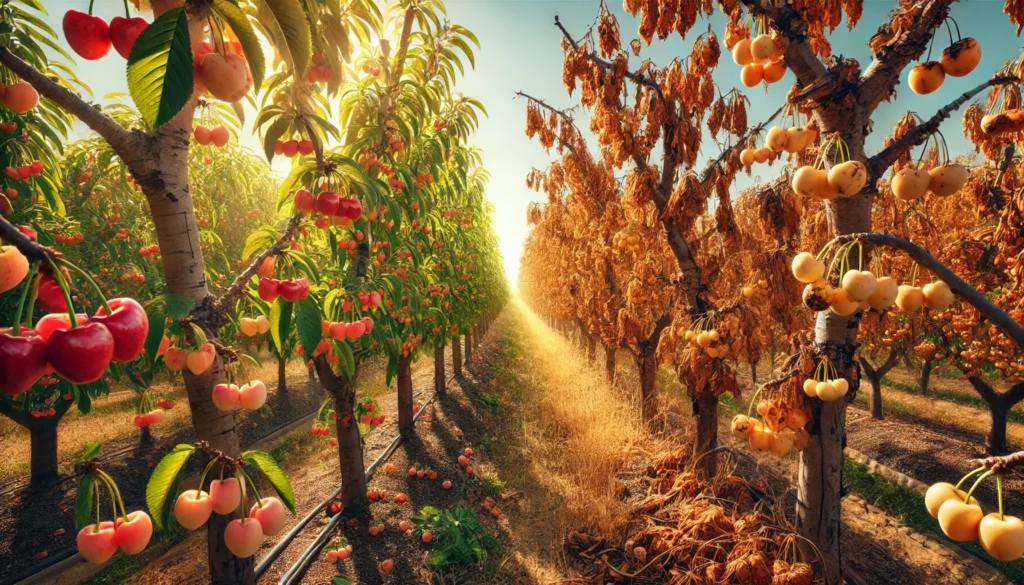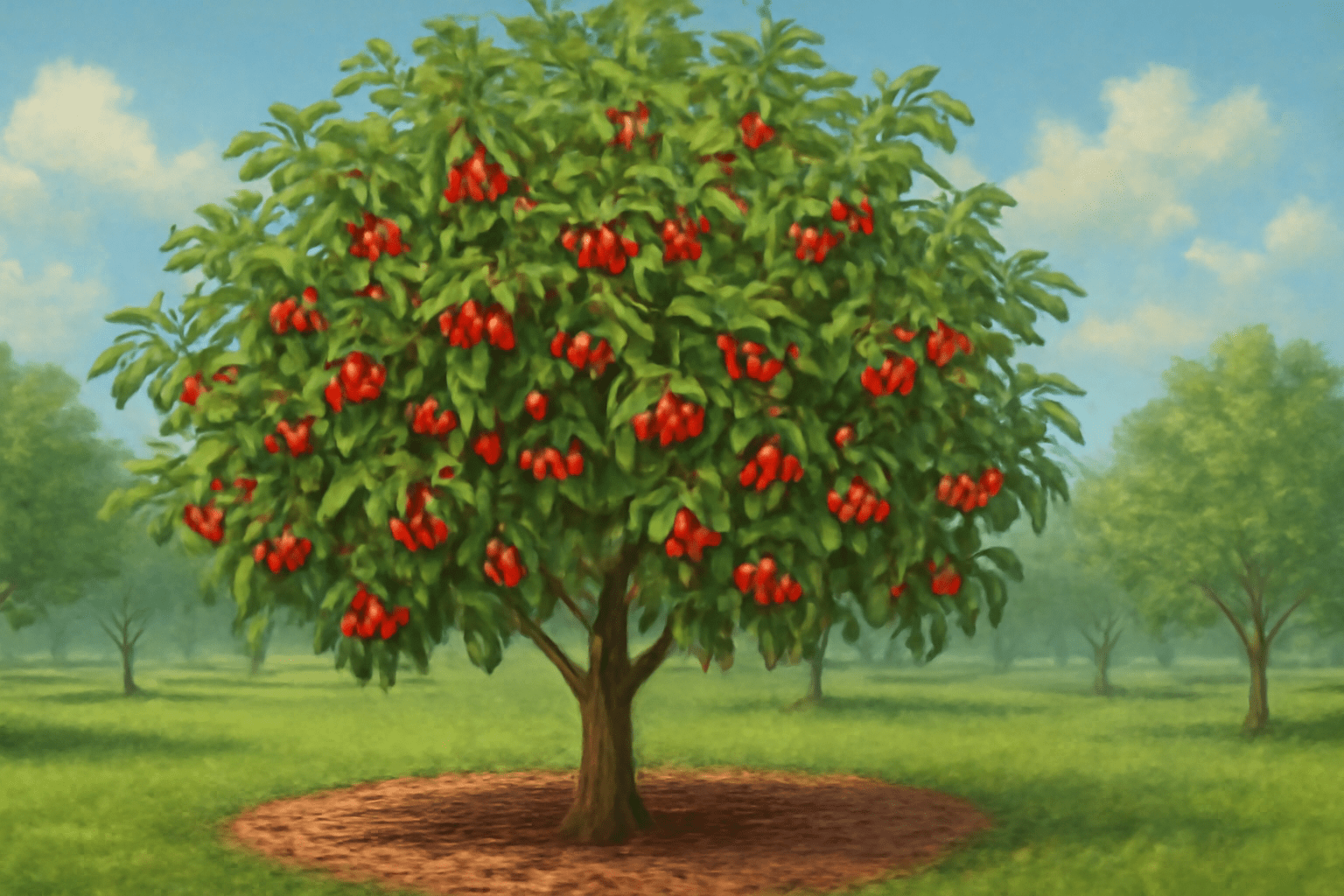
Cherry Tree Brown Rot: Prevention, Identification, and Treatment for a Healthy Harvest
Cherry tree brown rot is a common and destructive fungal disease that can wreak havoc on your fruit harvest, leaving you with rotting cherries and a sense of frustration. If you’re growing cherry trees, understanding Cherry Tree Brown Rot: Prevention, Identification, and Treatment is crucial for maintaining a healthy, thriving orchard. This disease not only affects the fruit but can also damage the tree itself if left unchecked. In this guide, we’ll walk you through how to spot brown rot early, prevent it from spreading, and treat it effectively to ensure a bountiful, healthy harvest year after year.
Table of Contents
ToggleWhat is Cherry Tree Brown Rot? 
Cherry Tree Brown Rot is a common fungal disease caused by Monilinia species, mainly Monilinia fructicola. It affects cherry trees, causing brown, decayed fruit and sometimes even killing branches. This disease thrives in warm, moist conditions and can spread quickly, especially during the blooming and fruiting periods.

Symptoms include:
- Brown or tan discoloration on fruit.
- Soft, mushy spots where the fruit decays.
- Dark, sunken lesions on twigs and branches.
- A white, fluffy fungus that appears when humidity is high.
It’s essential to address this disease quickly, as it can ruin your harvest and harm the overall health of your cherry tree. Early intervention is key to preventing major crop loss!
What is Cherry Tree Brown Rot? Identifying Cherry Tree Brown Rot 
Cherry Tree Brown Rot is a fungal disease that affects cherry trees, causing the fruit to decay and the tree’s health to decline. It’s caused by the Monilinia fungus, which thrives in warm, moist conditions. Here’s how you can identify it:
- Initial Signs of Infection:
Brown rot begins as small, water-soaked spots on the cherry fruit. These spots quickly turn brown and mushy, and the fruit may shrivel or collapse.

- Symptoms on Blossoms:
Infected blossoms turn brown, shrivel, and die. This usually occurs during the spring bloom, significantly affecting fruit yield.
- Canker Development:
As the disease progresses, brown rot can cause dark, sunken cankers on branches and stems, making the tree more vulnerable to other infections.
- Spread of the Disease:
The fungus spreads rapidly through wind, rain, or infected pruning tools, so it’s important to act quickly.
- Presence of Spore Masses:
You might notice white, cotton-like masses of fungal spores on infected areas. These spores spread the disease to healthy parts of the tree and nearby plants.
Why It’s Important to Identify Early: Timely identification of cherry tree brown rot can help save your tree and prevent further damage. Treating the disease early with proper fungicides and sanitation practices will keep your cherry tree healthy.
How Cherry Tree Brown Rot Spreads 
Cherry tree brown rot is a sneaky and destructive disease caused by the Monilinia fungus. It primarily spreads through spores, which are easily carried by wind, rain, or even insects 
Spore Dispersal: During damp weather, the brown rot fungus releases spores into the air. These spores can travel long distances, landing on healthy trees in the vicinity 

Infection via Wounds: The spores need a way into the tree. Wounds caused by pruning, physical damage, or even insect activity provide the perfect entry points for the fungus 
Moisture Makes It Worse: Once the spores land on a tree, they require moisture to germinate and infect. Heavy rain or excess humidity creates an ideal environment for the fungus to thrive 
Fruit to Fruit Transmission: Infected fruit can drop to the ground, where the fungus can spread further. If not promptly removed, it contaminates the surrounding plants 
Key Prevention Tip: Regularly prune your cherry tree and ensure good air circulation to reduce humidity around the tree. This will help limit the spread of spores 
By understanding how the disease spreads, you can take proactive steps to protect your cherry trees and keep them healthy!
Preventing Cherry Tree Brown Rot 

To protect your cherry tree from brown rot, here are some essential steps you can follow:
Prune Regularly 

Clear the Area 
Apply Fungicide 
Water Correctly 
Choose Resistant Varieties 
By following these tips, you can keep your cherry tree healthy and minimize the chances of brown rot affecting your harvest!
Treating Cherry Tree Brown Rot 
Cherry tree brown rot is a fungal disease that can cause significant damage to your tree, leading to the decay of blossoms, fruit, and even branches. Fortunately, with the right approach, you can prevent and treat this issue effectively. Here’s how:
1. Prune Infected Areas 
Cut away any infected branches or fruit immediately. Brown rot tends to spread quickly, so removing these parts helps reduce the risk of further contamination. Always disinfect your pruning tools between cuts to avoid spreading the fungus.
2. Improve Air Circulation 
Ensure proper spacing and airflow around your cherry tree. Crowded branches and poor airflow create a humid environment perfect for fungal growth. Thin out the branches to increase sunlight exposure and airflow.
3. Apply Fungicide 
Use a fungicide that targets brown rot. Fungicides containing captan or thiophanate-methyl are effective. Apply at the correct time, usually in early spring before blooming and again during fruit formation, following label instructions carefully.

4. Remove Fallen Debris 
Collect and dispose of any fallen leaves, fruit, or branches. Brown rot spores can overwinter in this debris, so keeping your garden clean helps reduce the risk of reinfection.
5. Watering Practices 
Avoid overhead watering, as this can spread the spores. Water your tree at the base, ensuring the soil is well-drained to prevent waterlogged conditions, which favor fungal diseases.
By following these practical steps, you’ll help your cherry tree thrive and protect it from brown rot!
Managing Brown Rot Throughout the Growing Season 
Brown rot can devastate your plants, but with the right strategies, you can keep it under control throughout the growing season. Here’s how to manage this pesky problem effectively:
Early Detection is Key
Start by inspecting your plants regularly for any signs of brown rot, such as discolored or shriveled fruit. Early detection allows you to act before the disease spreads.
Proper Watering
Avoid overhead watering, as moisture on the leaves and fruit creates a perfect breeding ground for rot. Water at the base of the plant to keep the foliage dry.
Pruning and Cleaning
Remove infected branches, flowers, or fruit immediately to prevent further spread. Always sterilize your pruning tools to avoid transferring the infection. Regularly clean up fallen debris, as it can harbor spores.
Maintain Air Circulation
Space out your plants to improve airflow, which helps reduce humidity and keep fungal growth in check. Proper spacing also ensures that your plants dry faster after rain or watering.

Fungicide Application
Use a fungicide that targets brown rot early in the season, especially after pruning. Follow the manufacturer’s instructions for timing and application frequency to maximize effectiveness.
Rotation and Resistant Varieties
If possible, plant resistant varieties of plants, especially fruits, that are less susceptible to brown rot. Additionally, rotate crops yearly to break the cycle of the disease.
By staying vigilant and adopting these management techniques, you can reduce the impact of brown rot and ensure a healthier, thriving garden. Happy planting!
Protecting Your Harvest 

When it comes to protecting your harvest, ensuring your plants are safe from pests, diseases, and the elements is crucial to getting the best yield. Here are some expert tips to help you protect your hard work and enjoy a bountiful harvest:
1. Pest Control 

- Natural Predators: Encourage beneficial insects like ladybugs, lacewings, and predatory beetles to keep pest populations in check.
- Neem Oil: Use neem oil as a natural pesticide. It’s gentle on plants but tough on harmful insects.
- Diatomaceous Earth: Sprinkle diatomaceous earth around your plants to deter crawling insects without chemicals.
2. Mulching 

- Weed Prevention: Apply a thick layer of mulch to keep weeds at bay. This also retains soil moisture and regulates temperature, keeping your plants healthy.
- Organic Mulch: Use organic materials like straw, leaves, or grass clippings for a natural mulch option that benefits your soil.
3. Covering Your Plants 

- Row Covers: Use floating row covers to shield delicate plants from pests, frost, and strong winds while still allowing sunlight to reach them.
- Frost Protection: For colder months, wrap your plants with frost blankets to prevent freeze damage during unexpected cold spells.
4. Regular Inspections 

- Check for Signs of Trouble: Examine your plants regularly for any signs of pests or diseases like yellowing leaves or holes. Early detection helps prevent widespread damage.
- Trim Dead Leaves: Remove any unhealthy parts of your plants to prevent the spread of disease and encourage new growth.
5. Proper Watering 

- Avoid Overwatering: Too much water can lead to root rot and attract pests. Ensure your plants are getting just the right amount—consistent but not excessive watering is key.
- Water in the Morning: Watering in the morning helps prevent the growth of mildew and mold, which thrive in damp, cool conditions.
With these strategies in place, you’ll be able to safeguard your harvest and enjoy a thriving garden. 
Final Tips


Cherry tree brown rot can be a devastating problem for gardeners and orchardists alike, but with the right knowledge and proactive care, it’s possible to prevent, identify, and treat this disease effectively. By choosing resistant varieties, maintaining proper tree care practices, and using the right treatment methods, you can safeguard your cherry trees from brown rot and ensure a bountiful harvest year after year. Remember, early detection is key, so be vigilant throughout the growing season. With these essential tips, your cherry trees will thrive, delivering juicy, healthy fruit without the threat of brown rot. Stay proactive and protect your investment for a fruitful future!
Frequently Asked Questions(FAQ)
What is Cherry Tree Brown Rot?
Cherry tree brown rot is a fungal disease caused by the Monilinia species. It primarily affects cherries, causing fruit to rot and become mushy, and can also impact blossoms and branches.
How do I identify Cherry Tree Brown Rot?
You can identify brown rot by the appearance of brown, decaying spots on the fruit, often accompanied by a soft, mushy texture. On blossoms, the flowers may wilt and turn brown. Infected branches may show signs of cankers or lesions.
How does Cherry Tree Brown Rot spread?
The disease spreads through fungal spores carried by wind, rain, and contaminated tools. It can also spread through infected fruit and debris left on the ground.
How can I prevent Cherry Tree Brown Rot?
To prevent brown rot, choose resistant cherry tree varieties, prune for better airflow, remove infected fruit and debris, avoid overhead watering, and disinfect pruning tools regularly.
What are the best treatment options for Cherry Tree Brown Rot?
Treatment options include removing infected fruit and branches, applying fungicides (both chemical and organic), and following proper cultural practices like thinning the fruit and ensuring good tree sanitation.
When should I apply fungicides to prevent brown rot?
Fungicides should be applied during the flowering stage, before rain or moisture sets in. Reapply as needed according to the product instructions, especially during the fruit development phase.
Can organic methods treat Cherry Tree Brown Rot?
Yes, organic treatments like neem oil and sulfur can be effective in preventing and treating brown rot, though they may require more frequent applications compared to chemical fungicides.
How do I manage brown rot during different seasons?
In spring, focus on prevention during flowering. In summer, monitor fruit and remove any infected ones. In fall, clean up fallen fruit and leaves to prevent spores from overwintering.




